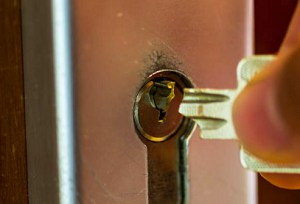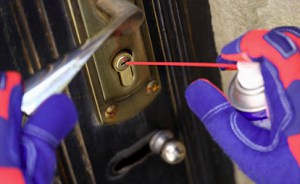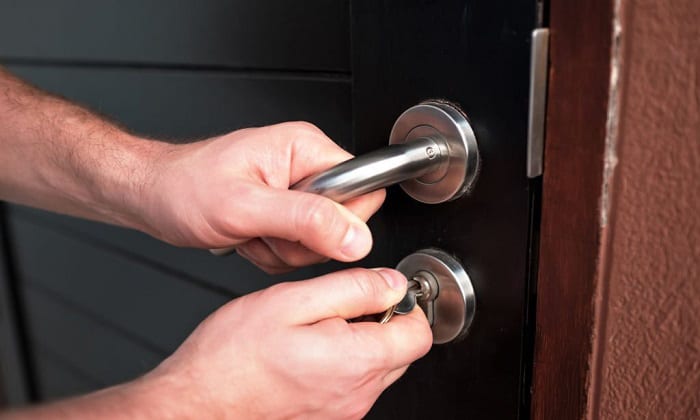Having a door lock won’t turn all the way is a hassle, especially when you are in a hurry. It can also pose a security risk, especially if you need to lock the door to go out.
Fortunately, you don’t always have to rely on a professional to address your door lock problems. Common household tools, such as WD-40 or screwdriver, can help you fix your front door lock and other security bolts around the house.
In this article, I will show you how to fix a door lock that won’t turn with these simple and easy steps.
Ways to Fix a Door Lock That Won’t Turn
There are various reasons your key won’t turn in lock. Therefore, you first need to identify the underlying problem first in order to identify the best way to fix a door lock cylinder.
If your key won’t go in lock because a previous key broke and stuck into the keyhole of the lock, follow these simple steps:
- Try using a pair of tweezers to pull the piece of broken key out of the hole in a straight motion. If it doesn’t work, move on to the next step.
- Align the nozzle of WD-40 with the keyhole and spray a generous amount.
- Find a knife with a pointy tip – it should be small enough to wedge into the space between the hole and the piece of the broken key. To make the process easier, you can use two knives simultaneously for either side of the key.
- Slide the tip of the knife into the keyhole the further, the better.
- Gently flick the knife so that it’ll push the broken key piece out.
- Remove the stuck key. If the majority of the parts of the stuck key is out, pull it out with your fingers.
If you have a problem where you say, “my key won’t unlock my door,” it might be because the hinges holding the door knob in place are loose. Follow these quick and easy steps to circumvent the issue:
- To identify if this is truly the problem, grasp the handle and try lifting the door. If it does inch upward, your door hinges are loose.
- Fully open the door to fully expose the screws.
- Find a screwdriver whose bit can entirely fill the screw heads so that you can spin it without slipping.
- If the screws are old and rusty, spray them with WD-40. If not, you can skip this step.
- Tighten the screws by turning them clockwise with the screwdriver.
- Check alignment. Make sure that the screws are tightened enough that the latch and the striker plate are aligned.
- If tightening old screws doesn’t do the trick, remove them. Instead, keep the hinges in place with wooden matches dipped in carpenter’s glue—you’ll need to use a hammer to drive them into position.
If your key fits in lock but won’t turn, it can be attributed to the loose set screw of your door lock. You might want to follow these steps to fix that door lock of yours:
- Go get your screwdriver. Make sure that you have the appropriate screwdriver for your door knob’s screws.
- Find the knob’s set screws, which are usually located on the knob’s neck or underneath the faceplate.
- Turn the set screws counterclockwise to tighten them.
If the deadbolt key won’t turn when you turn the knob, the mechanism inside the lock might be getting sticky. Do these steps to fix your lock’s interior and get your door moving:
- Prepare your lubricant. Ideally, it should be a Teflon or a polytetrafluoroethylene (PTFE) lubricant, as they’re best for dry application. In contrast, oil-based lubricants attract more dust, which can cause the lock to get stuck again.
- Squirt the lubricant into the keyhole. Then slide the key back and forth into the keyhole to spread the lubricant evenly.
- Try turning the key; if it still doesn’t turn, move on to the next step.
- Use a screwdriver to remove the set screw from the knob and expose the deadbolt’s spindle.
- With the right lubricant, spray a small amount on the spring and spindle of the deadbolt.
- Clean the inside of the knob first to get rid of the unwanted particles and to make sure the lubricant stays intact.
- Reassemble the doorknob.
If your key not turning in lock, the problem can be due to the temperature being so cold that the locking mechanism is frozen. Here’s how to circumvent the issue:
- Pour hot water into a container.
- Put your key inside the container. Wait for a few minutes before fishing the key out of the water.
- To avoid rusting inside the lock, you should quickly dry your key first before inserting it into the lock
- Insert the key. Once your key is already dry and hot, insert your key into the lock and slowly turn it.
- If the lock starts to budge but still doesn’t fully turn, you can repeat the steps above, or switch to using a hair dryer to blow hot air into the keyhole.
Note: you might want to hold the key with a cloth to avoid burning your hand.
Why is the Door Lock Not Turning?
If you find your door lock not turning when you unlock it with key, it might be attributed to different causes, such as the weather, season, temperature, or even because of age.
To find out why your door lock won’t turn from inside, here are a couple of common causes:
- The space inside your door lock can accumulate dust and dirt, especially when the surrounding environment is open and dusty. The unwanted particles inside the lock might clog the pins, making it difficult to turn.
- You have a bent key. If you notice that your key suddenly not working in lock, it might be because your key has been bent and cannot function properly.
- During the winter, your lock may become frozen, making the door lock hard to turn key.
- The key is not compatible. Check the key you are using, as you might have confused another key to your door key when your key fits in lock but won’t turn.
- The key tip has become blunt. This can happen if you regularly use your key for purposes other than opening your door.
- Lock pins are worn out after years of being in use.
- You might have broken a key, and a part of it is stuck inside the lock.
- The door is not positioned correctly. Your UPVC door key won’t turn because of the locking point alignment issue, especially on the door’s hinges.
- The lockset is broken. A broken lockset could mean different things, ranging from someone trying to lock pick or breaking it with a hammer or a crowbar.
- The lockset isn’t compatible with the door. If your door lock can turn when the door is open but will not turn when closed, your lockset may not be the right one for your door.
Conclusion
Having a trusty door lock that works will keep your valuables and even your family safe from harm. With a safe and secure home or office, you can live the healthy lifestyle that you deserve.
Learning how to fix a door lock that won’t turn will help you save money from hiring a locksmith. It will also improve your handiness and make you a more reliable asset to your family and to your company.

I am the last member to join Revolar and might be just the luckiest to work with dedicated people like Teddy and John. Our team has established a process where my only job is writing the best content to deliver incredible ideas and guides.







